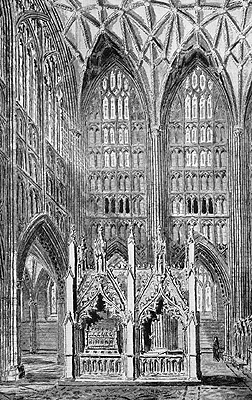
EBK Home
Kingdoms
Royalty
Saints
Pedigrees
Archaeology
King Arthur
Mail David
Glastonbury Shrines
Part 7: St. Dunstan enshrined at Glastonbury or Canterbury?
 St.
Dunstan was, of course, the most famous of Glastonbury's Abbots.
He was chief advisor to a number of 10th century Saxon Kings and went on
to become Archbishop of Canterbury. He died at the centre of his
Archiepiscopal See in AD 988 and was suitably enshrined in his Cathedral
there.
St.
Dunstan was, of course, the most famous of Glastonbury's Abbots.
He was chief advisor to a number of 10th century Saxon Kings and went on
to become Archbishop of Canterbury. He died at the centre of his
Archiepiscopal See in AD 988 and was suitably enshrined in his Cathedral
there.
Dunstan had been well-known for his accomplishments in the art of metalworking. Glastonbury Abbey held a number of objects made by his own hands (some can still be seen today at Mayfield Convent in East Sussex) and the establishment had its own shrine to the holy man in the form of his old workshop which stood very near the 'Old Church'. It was here that the saint supposedly had his legendary encounter with the Devil. Dunstan's biographer described the building, as it appeared in the 12th century, thus:
"Adjoining the church [St. Dunstan] built a cell with his own hands. It is a lean-to or a sort of den.....It is more like a tomb than a human dwelling. Let me record what I myself saw, that.....the length of his cell is not more than five feet and its breadth, two and a half feet. Moreover, the height equals the stature of a man if he were to stand in the dug-out earth, otherwise it would not reach even to his chest.....So it is clear that he never lay down to sleep and always stood to pray. What was a door to him who entered, became a wall to him who had entered. For, indeed, in such a small building, it was impossible for a door to be made except of the whole side. There is a small window in the middle of the little door through which light shone on the labourer."
Like the 'Old Church,' St. Dunstan's cell may have been destroyed during the Great Fire of 1184 and St. Dunstan's Chapel was later erected over the site, to the west of the great Abbey Church. It seems, however, that such a holy spot was not enough for the monks of Glastonbury and, after the Abbey was destroyed in the this famous fire, they claimed to have miraculously discovered, not only the body of King Arthur, but of St. Dunstan too.
The story told to explain such a wonder was not a new one. Like the great monasteries of the North, Canterbury had always been prone to Viking attacks. In September 1011, it was sacked by the Danes and the Archbishop, St. Alphege, was kidnapped. His brethren fled the city and the unfortunate man himself was later martyred at Greenwich. During this time, a delegation of four opportunists from Glastonbury apparently arrived at the abandoned cathedral in Canterbury. Identifying Dunstan's body from a ring on his finger, they gathered up the his remains and solemnly brought them back to their abbey - where the bells sounded unaided to display the saint's pleasure at returning home! Worried about the reaction of the Canterbury monks, the bones were hidden away and conveniently revealed in the Abbey's darkest hour after the fire of 1184.
The people of Canterbury, not least the Archbishop, were naturally unimpressed by these Glastonbury claims. The contemporary Eadmer of Canterbury wrote, "I was not a little confounded to hear such a foolish and even laughable story." Still, a shrine was erected and pilgrims visited Glastonbury to pray at St. Dunstan's side. In the early 16th century, Abbot Beere made much of the relics and even moved them to a much more prominent position, probably in the Edgar Chapel. Their increased popularity led Archbishop Warham to write to the Abbot in 1508. He explained that Canterbury's own coffin of St. Dunstan had recently been examined and was found to contain a complete skeleton of a man in full archiepiscopal dress, described on a lead sheet therein as "Sanctus Dunstanu Archiepiscopus". Beere, he suggested, should therefore desist from his scandalous assertions. The Abbot of Glastonbury was not easily dismissed, however, and quickly replied that, though a few small bones may have been returned to Canterbury at some point, he was loathed to prevent the devoted from venerating the majority which undoubtedly lay in his own Abbey. Further, he advised that the Canterbury monks should suppress their own relics until they were sure that they were not counterfeit. Amazed by the Abbot's audacity, William Warham commanded Beere to appear before him with the supposed relics by the All Saints' Day following at the latest. Abbot Beere simply ignored the summons and the Glastonbury Shrine of St. Dunstan continued to flourish until the Reformation.
Click for Next Section
